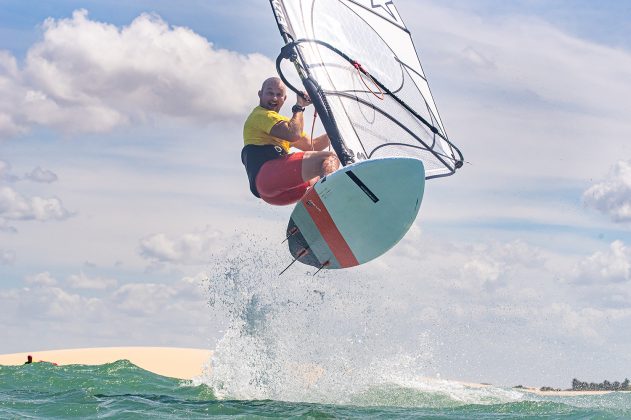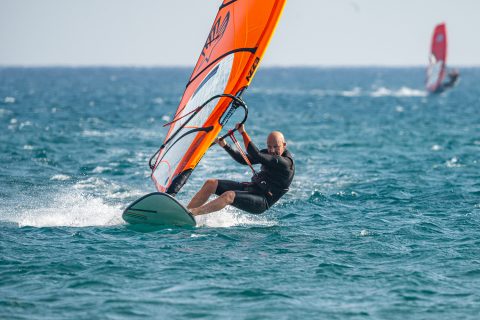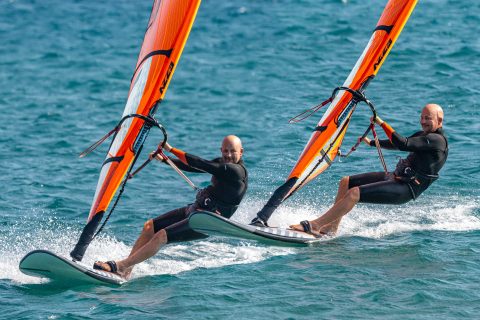JEM HALL
MOVE ON UP
MINOR CHANGES, SIGNIFICANT GAINS
MOVE ON UP JEM HALL: MINOR CHANGES, SIGNIFICANT GAINS
Super 6: Jem Hall suggests 6 subtle technique changes, which pack a punch and can provide significant benefits to your sailing.
Photos: Eye Sea You
This month we take a look again at how making a few subtle, but precise changes to your technique can yield some massive benefits. The added bonus is that these small changes will not only assist your progression, but they will also challenge you and refresh how you view your technique. I will provide a Super 6 of actions to work on and provide the tips, and / or benefits, where relevant. You can further boost your gains by reading the changes I previously implored you to embrace from my Jan / Feb ’23 article.
Jump before you gybe: Why? I hear you ask… well, because jumping is fun and it is also safer to know how to jump before your board inadvertently leaves the water in strong winds, bumpy water or waves, so you don’t land in a heap, or even more importantly, hurt yourself.
Furthermore, gybing is hard, and it takes time to learn. So, if you are planing, and your board isn’t too big, then you might as well: “Jump, jump, jump.”. Get into it by learning the pop from an over the board position. More info and tips can be found in my March ’17 article called ‘Jump the Bump.’
- Pull down on the boom by getting out and down with a really bent back leg.
Pull down on the boom: This is a huge, huge tip! I would say that over the last 3 years of coaching I have really understood just how powerful ‘pulling down on the boom’ is and along with ‘bending your back leg’, these actions often yield the biggest dividends. Firstly, in order to pull down on the boom you have to be low and outboard, which is already a great place to be. Then the actual action of pulling down on the boom will help you appreciate just how much physicality, and focus, it requires to do so. This will then inspire you to up your fitness and strength game. Pulling down, as opposed to in, uses so many different muscles!
The main areas where pulling down on the boom helps include: Getting planing by keeping the board flat, getting into the footstraps, as this lightens the load on your feet, settling the board when well powered up, keeping the rail engaged when carving, and last, but not least, for you forward loopers, pulling down on your front arm will really help add some whip to your rotation!
Unhook by bending your arms: This follows on from the previous point. Pulling down is facilitated by being outboard, and when blasting, pulling down means dropping our hips and getting plenty of weight into the harness lines. From this strong position, and with plenty of weight in your lines, you will then have plenty of tension in your lines, so it merely requires a subtle bend of the elbows to unhook.
The main benefit here is that by only bending your arms to unhook, you will keep the board significantly more settled. Many standup to unhook, which can be catastrophic as it unsettles the board and often leads to you staying hooked in to floppy lines. The result is one we all know far too well… FFFFWWHHHACCK!
- Get out and tension those lines before unhooking by ONLY bending your arms!
This action can also be traced back to my advice of ‘precision in your preparation’ for moves like tacks, gybes, carving manoeuvres and jumps.
Get into it by really focusing on just bending your arms to unhook before you tack, gybe or jump. One mantra I coach is to get the lines ‘tight like piano strings’ prior to unhooking, which helps enormously.
Roll from your heels to your toes to carve: Many boardsports exhibit this action, think; snowboarding, surfing or paddleboarding in waves. It is a very subtle movement when carve gybing for example, you put a just little bit of weight on your heels before you roll forward, with soft ankles, to initiate the carve. This helps ‘slingshot’ you (so to speak) into the carve, which is often further helped by the vee under the mast track / midpoint in many boards.
If we take it a step further into wave riding, then dropping down the wave and weighting your heels will help you create some distance between yourself and the wave, which gives you the time, and space, to carve a nice frontside bottom turn back up the wave. This is an extra benefit alongside the ‘slingshot’ effect. Many people ‘wiggle’ too close to the wave, so I coach my people to ‘come away from the wave’ in order to get back up it and then take the energy (speed) to push you back down. You can find more tips in my ‘Changing Lines’ article from Jan / Feb ’21, which will also set you up for my next tip.
- This space away from the wave, and smooth rail-to-rail carving will give you the speed to carve back up the wave in order to accept its energy.
B****y Scissor will you; the act of scissoring is moving your legs in opposing directions, for example, pushing your front leg to straighten as you pull on your back leg, and this can be exhibited in how you bear away to get planing. I feel like windsurfers in general don’t scissor enough. The number one crime I accuse them of is unhooking and then going straight into a gybe without any scissoring, which would help lighten the sail and also increase speed. Both of which will seriously help any carving move. So, please get out there and scissor. These are the key areas to focus on:
– Scissor further downwind to get planing earlier.
– Scissor a little when blasting in order to keep speed through a lull.
– Scissor slightly downwind before a tack, so as to gain speed and stabilise the board before carving upwind.
– Scissor upwind a little when confronted by a powerful gust when blasting.
– Takeoff across the wind when jumping, but scissor downwind in the air to maintain momentum from an outboard position.
– Scissor the board A LOT when forward looping by over exaggerating this action with your legs. I always feel the sensation of a straight / pushing front leg, and super bent back leg when I execute a textbook, sideways rotation.
– Scissor the board along the wave to generate extra speed before you drop down and then away from the wave, prior to your ride.
– And Yes B****y Scissor before you carve gybe, duck gybe or carve 360.
- Drop down the wave and transfer a little bit of weight on to your heels to take you away from the wave and help you roll forwards and carve into your bottom turn.
On the edge: When blasting on single back strap boards, or even with double back straps positioned more inboard, you can help keep the rail down by sliding your backfoot closer to the rail. I even edge my front foot out of the strap a little on a longer upwind run. This not only locks down the edge, but it is also way less tiring on our shins.
If we are low, fast and outboard, then we are generating speed, which in turn means the water flows faster over the fin(s), which produces more lift and results in the windward (upwind) rail wanting to lift. Counteract this by getting out to lock the rail down.
My feet are very active in my straps on a wave or freewave board – in to jump, carve, or ride, and then out to cruise, blast or head upwind.
Tuning: You know I am always asking you to tune. This might be by changing fin(s), boom height or mast foot position, but also by adjusting your downhaul or outhaul tension. Now, I am asking you to do some of this sail tuning in the water… yikes!
At many spots, I can’t easily get back to the beach to tune as it may be too rocky, or there may be a heavy shorebreak for example, so I sail out a bit past the breaking waves, or the crowds, and then jump in the water and change my outhaul a few centimetres, in the required direction. I can even downhaul out at sea if required, which has transformed many a session.
Tuning in deeper water is often safer too as less people can sail into you, as Windies do tend to like to congregate and turn too close to the beach, don’t they… ahem… naming no names!
- Move your feet to the edge to keep the rail down and board flat.
Ezzy Sails, RRD (boards, wetsuits & softwear), Chinook & Black Project Fins sponsor Jem Hall. Get him live and direct on one of his highly acclaimed coaching holidays – checkout his website www.jemhall.com for details. You can also follow him on X / Facebook / Instagram.






